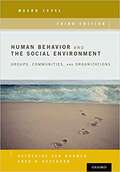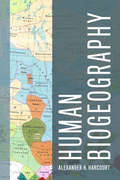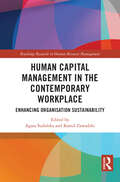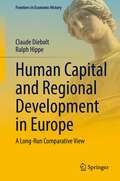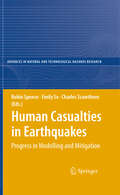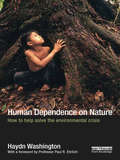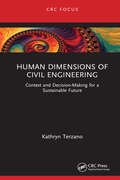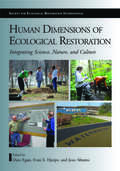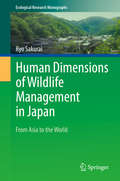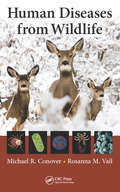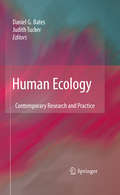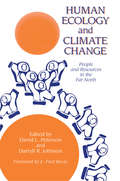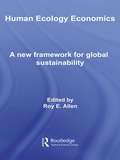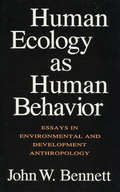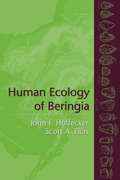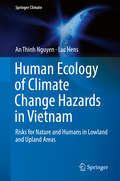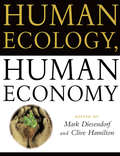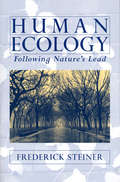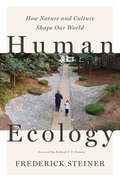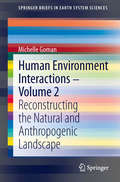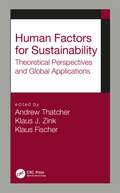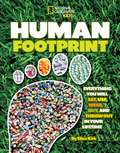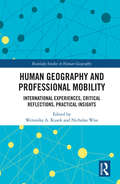- Table View
- List View
Human Behavior and the Social Environment, Macro Level: Groups, Communities, and Organizations
by Katherine Van Wormer Fred BesthornA timely revision in this global age, Human Behavior and the Social Environment, Macro Level develops a sophisticated and original view of the cultural, global, spiritual, and natural worlds that people inhabit, and explores the impact of these worlds on human behavior. An ecosystems/sustainability framework emerges as a key characteristic of contemporary practice. What is sustainable social work? What are the characteristics of a sustainable community? How is the present exploitation of environmental resources unsustainable for future generations? In accordance with the 2015 Council on Social Work Education (CSWE) standards, attention is paid to environmental justice as well as diversity and difference.
Human Biogeography
by Alexander H. HarcourtIn this innovative, wide-ranging synthesis of anthropology and biogeography, Alexander Harcourt tells how and why our species came to be distributed around the world. He explains our current understanding of human origins, tells how climate determined our spread, and describes the barriers that delayed and directed migrating peoples. He explores the rich and complex ways in which our anatomy, physiology, cultural diversity, and population density vary from region to region in the areas we inhabit. The book closes with chapters on how human cultures have affected each other's geographic distributions, how non-human species have influenced human distribution, and how humans have reduced the ranges of many other species while increasing the ranges of others. Throughout, Harcourt compares what we understand of human biogeography to non-human primate biogeography.
Human Capital Management in the Contemporary Workplace: Enhancing Organisation Sustainability (Routledge Research in Human Resource Management)
by Agata Sudolska and Kamil ZawadzkiNowadays, organisations are confronted with the imperative to enhance their organisational sustainability. This involves establishing an appropriate balance between the economic, ecological, and social aspects of an organisation's operations and striving to accomplish their economically viable goals that are both socially and environmentally responsible. By aligning the priorities and incorporating environmental, social, and economic factors into their operational strategies, organisations can generate value for themselves, while also making a positive impact on the current and future welfare of society and the environment. Noticeably, the advancement of organisational sustainability relies heavily on human capital management in the workplace.Today, more than ever, human capital is regarded as the foundation of organisations and ought to be treated as such. Given the pivotal role of human capital management for ensuring the long-term organisational sustainability of an organisation, emphasis should be placed on redefining leadership strategies and priorities, focusing on diversity and inclusion, cultivating talent, facilitating remote work, fostering employee engagement, promoting skill development for environmentally friendly practices, and prioritising job satisfaction and employee well-being.In response to the multi-faceted challenges of the third decade of the 21st century, this book provides an in-depth review of research avenues addressing present and future human capital development concerns in terms of enhancing organisation sustainability. The main aim of the book is to indicate the direction of demand for new competences regarding workplace human capital and identify synergies between its particular aspects with reference to contemporary human capital development. The monograph’s objectives include presenting tools that allow the analysis and development of human capital competences, pro-active and pro-environmental attitudes and behaviours, the coexistence of workers and AI in the organisation, as well as providing employee well-being, satisfaction, and commitment. Moreover, the book offers recommendations for contemporary responsible organisations that carry themselves towards the new economic and social order and sustainability.
Human Capital and Regional Development in Europe: A Long-Run Comparative View (Frontiers in Economic History)
by Claude Diebolt Ralph HippeHuman capital is of utmost importance for the future of our knowledge economies and societies. However, it is unequally distributed in Europe, contributing to marked spatial patterns of economic prosperity within and across countries. In many cases, these patterns have a long history. To understand them better, it requires to go back in time, when mass schooling was starting to become a reality across Europe. Taking a long-run perspective over more than 150 years, this book shows the development and the distribution of human capital in the regions of Europe and its connections with the economy. It provides insights into recent research findings in this area, including theoretical advances and the use of new empirical data.
Human Casualties in Earthquakes
by Emily So Charles Scawthorn Robin SpenceAssessment of human casualties in earthquakes has become a topic of vital importance for national and urban authorities responsible for emergency provision, for the development of mitigation strategies and for the development of adequate insurance schemes. In the last few years important work has been carried out on a number of recent events (including earthquakes in Kocaeli, Turkey 1999, Niigata Japan, 2004, Sichuan, China 2008 and L'Aquila,Italy 2009). These events have created new and detailed casualty data, which has not until now been properly assembled and evaluated. This book draws the new evidence from recent events together with existing knowledge. It summarises current trends in the understanding of the factors influencing the numbers and types of casualties in earthquakes; it offers methods to incorporate this understanding into the estimation of losses in future events in different parts of the world; it discusses ways in which pre-event mitigation activity and post-event emergency management can reduce the toll of casualties in future events; and it identifies future research needs.
Human Dependence on Nature: How to Help Solve the Environmental Crisis
by Haydn WashingtonHumanity is dependent on Nature to survive, yet our society largely acts as if this is not the case. The energy that powers our very cells, the nutrients that make up our bodies, the ecosystem services that clean our water and air; these are all provided by the Nature from which we have evolved and of which we are a part. This book examines why we deny or ignore this dependence and what we can do differently to help solve the environmental crisis. Written in an accessible and engaging style, Haydn Washington provides an excellent overview of humanity’s relationship with Nature. The book looks at energy flow, nutrient cycling, ecosystem services, ecosystem collapse as well as exploring our psychological and spiritual dependency on nature. It also examines anthropocentrism and denial as causes of our unwillingness to respect our inherent dependence on the natural environment. The book concludes by bringing these issues together and providing a framework for solutions to the environmental crisis.
Human Dimensions of Civil Engineering: Context and Decision-Making for a Sustainable Future
by Kathryn TerzanoWritten to complement civil engineers’ technical knowledge, this book explains the sociocultural contextual knowledge that civil engineers need if they are to be effective in their professions. Civil engineers design and build the world in which we all live. The decisions that they make can guide us toward a more sustainable society since the infrastructure that they create has a direct impact on how sustainably we are able to live. Sustainability is value-laden, however, and embedded within larger contexts. Whilst engineers are well versed in technical matters and the evaluation of physical contexts, their education often leaves out essential knowledge about the larger social, cultural, economic, historical, and political contexts in which they operate. This book helps readers to understand contextual knowledge and why context matters—which is useful to engineering students and professionals who have found this topic absent from their education, who would like to understand contextual issues, and who would like to know why they should care. The book lays out essential sociocultural contextual knowledge for today’s civil engineers, relevant across a wide variety of workplaces.
Human Dimensions of Ecological Restoration: Integrating Science, Nature, and Culture (Science Practice Ecological Restoration)
by Jesse Abrams Evan E. Hjerpe Dave EganHuman Dimensions of Ecological Restoration takes an interdisciplinary look at the myriad human aspects of ecological restoration. In twenty-six chapters written by experts from around the world, it provides practical and theoretical information, analysis, models, and guidelines for optimizing human involvement in ecological restoration projects. The book delves into the often-neglected aspects of ecological restoration that ultimately make the difference between projects that are successfully executed and maintaned with the support of informed, engaged citizens, and those that are unable to advance past the conceptual stage due to misunderstandings or apathy. The lessons contained will be valuable to restoration veterans and greenhorns alike, scholars and students in a range of fields, and individuals who care about restoring their local lands and waters.
Human Dimensions of Wildlife Management in Japan: From Asia to the World (Ecological Research Monographs)
by Ryo SakuraiThis book discusses the findings of research on the human dimensions of wildlife management conducted in Japan, demonstrating how such research and approaches have contributed to mitigating human-wildlife conflicts.Human-wildlife conflicts, including agricultural and property damage as well as occasional casualties, are a global problem for which local residents, managers, and stakeholders around the world are struggling to find solutions. Human dimensions of wildlife management (HDW) is an academic field developed in North America in the 1970s to gather information on the social aspects of human-wildlife issues to help wildlife managers and stakeholders implement effective decision-making measures. However, HDW is not widely recognized or applied outside North America, and few studies have investigated whether HDW approaches would be effective in different cultural settings.This is the first book written in English to introduce the HDW theories and practices implemented in Asia. Presenting innovative approaches and research techniques, as well as tips on how to introduce HDW methods into culturally different societies, it is a valuable resource not only for researchers and students in this field, but also for government officials/managers, NGOs, residents and other stakeholders who are affected by human-wildlife conflicts around the globe.
Human Diseases from Wildlife
by Michael R. Conover Rosanna M. VailHuman Diseases from Wildlife presents information on the most prevalent and serious zoonotic diseases in the US and Canada, some of which have been national headline news like anthrax, influenza, and West Nile virus. Diseases that are caused by pathogens with the ability to infect both humans and animals are known as zoonotic diseases, which litera
Human Ecology
by Judith Tucker Daniel G. BatesThis comprehensive sourcebook on human ecology combines 25 source articles published in the journal Human Ecology, enhanced with new research updates and thematic commentary. Intended as a follow up to Case Studies in Human Ecology, this volume includes an entirely new group of articles, with the same accessible, comprehensive coverage that made Case Studies so popular. Human Ecology: Research and Practice covers four important areas: Philosophy, Theory and Methods; Changing Subsistence Practices; Agricultural Intensification and Population Dynamics; and, Common Property Resources and Conservation. As a group, these articles represent the major contributions to the study of Human Ecology since the publication of the previous volume. Each article includes a concise introduction by the Editor, giving necessary and thoughtful context. The volume covers an overview of human ecology as a field within environmental studies, new directions in contemporary research, new methods and techniques, and cultural landscapes. Anyone studying human ecology, environmental studies, landscape studies, or population dynamics, particularly key issues such as conservation and globalization will find this comprehensive reader a valuable resource.
Human Ecology And Climatic Change: People And Resources In The Far North
by David L. Peterson Darryll R. JohnsonThe Far North, a land of extreme weather and intense beauty, is the only region of North America whose ecosystems have remained reasonably intact. Humans are newcomers there and nature predominates. As is widely known, recent changes in the Earth's atmosphere have the potential to create rapid climatic shifts in our life-time and well into the future. These changes, a product of southern industrial society, will have the greatest impact on ecosystems at northern latitudes, which until now have remained largely undisturbed. In this fragile balance, as terrestrial and aquatic habitats change, animal and human populations will be irrevocably altered.
Human Ecology Economics: A New Framework for Global Sustainability (Routledge Frontiers Of Political Economy Ser.)
by Roy E. AllenThis book presentshuman ecology economics as a new and more comprehensive interdisciplinary framework for understandingworld conditions and human systems. This book helps economists rethink the boundaries and methods of their discipline - so that they can participate more fully in debates over humankinds present problems and on the ways that
Human Ecology as Human Behavior: Essays in Environmental and Developmental Anthropology
by John W. BennettHuman interaction with the natural environment has a dual character. By turning increasing quantities of natural substances into physical resources, human beings might be said to have freed themselves from the constraints of low-technology survival pressures. However, the process has generated a new dependence on nature in the form of complex "socionatural systems," as Bennett calls them, in which human society and behavior are so interlocked with the management of the environment that small changes in the systems can lead to disaster. Bennett's essays cover a wide range: from the philosophy of environmentalism to the ecology of economic development; from the human impact on semi-arid lands to the ecology of Japanese forest management. This expanded paperback edition includes a new chapter on the role of anthropology in economic development.Bennett's essays exhibit an underlying pessimism: if human behavior toward the physical environment is the distinctive cause of environmental abuse, then reform of current management practices offers only temporary relief; that is, conservationism, like democracy, must be continually reaffirmed. Clearly presented and free of jargon, Human Ecology as Human Behavior will be of interest to anthropologists, economists, and environmentalists.
Human Ecology of Beringia
by John Hoffecker Scott EliasTwenty-five thousand years ago, sea level fell more than 400 feet below its present position as a consequence of the growth of immense ice sheets in the Northern Hemisphere. A dry plain stretching 1,000 miles from the Arctic Ocean to the Aleutians became exposed between northeast Asia and Alaska, and across that plain, most likely, walked the first people of the New World. This book describes what is known about these people and the now partly submerged land, named Beringia, which they settled during the final millennia of the Ice Age.Humans first occupied Beringia during a twilight period when rising sea levels had not yet caught up with warming climates. Although the land bridge between northeast Asia and Alaska was still present, warmer and wetter climates were rapidly transforming the Beringian steppe into shrub tundra. This volume synthesizes current research-some previously unpublished-on the archaeological sites and rapidly changing climates and biota of the period, suggesting that the absence of woody shrubs to help fire bone fuel may have been the barrier to earlier settlement, and that from the outset the Beringians developed a postglacial economy similar to that of later northern interior peoples.The book opens with a review of current research and the major problems and debates regarding the environment and archaeology of Beringia. It then describes Beringian environments and the controversies surrounding their interpretation; traces the evolving adaptations of early humans to the cold environments of northern Eurasia, which set the stage for the settlement of Beringia; and provides a detailed account of the archaeological record in three chapters, each of which is focused on a specific slice of time between 15,000 and 11,500 years ago. In conclusion, the authors present an interpretive summary of the human ecology of Beringia and discuss its relationship to the wider problem of the peopling of the New World.
Human Ecology of Climate Change Hazards in Vietnam: Risks for Nature and Humans in Lowland and Upland Areas (Springer Climate)
by An Thinh Nguyen Luc HensThis book analyzes climate change associated effects in the mountainous and coastal environments of Vietnam. The scope of the book allows international comparisons to be made between these two affected areas and other similarly affected locations under constant environmental pressure. Frequent and intense climate change hazards are described, along with a wider context of integrated interpretations, socioeconomic implications and policy responses. The book reports on original research combining methodologies from the natural sciences with approaches in human sciences, providing an interdisciplinary human ecological context to analyze similar situations worldwide. The book is structured in four parts. The first part offers background information, and details the human ecological framework. The geography of the analyzed regions is discussed to reflect the environmental and socioeconomic context of Vietnam's coasts and mountains. The second part addresses the coast of Central Vietnam. The effects of tropical storms, floods, rising sea levels and coastal erosion in Ky Anh are studied to highlight the impacts on the local population and its development perspectives. The third part focuses on the uplands of Northern Vietnam. The effects of cyclones, heavy rains, floods, flash floods, and landslides in the Van Chan Mountains are studied to compare the biophysical and socioeconomic impacts. Part four makes policy recommendations in building resilient landscapes and green cities, and discusses the potential implications of findings for practice in Vietnam. The book addresses a wide array of researchers, geography and economics students, consultants and decision makers interested in the actual status and the likely developments on the physical, socioeconomic and mitigation and adaptation attitudes and policies of climate change associated effects.
Human Ecology, Human Economy: Ideas For An Ecologically Sustainable Future
by Mark Diesendorf; Clive Hamilton'A brilliant synthesis of ecology and economics that provides a sure guide to a sustainable future. It is a must for all environmentalists and economists.'Charles Birch'Written by an impressive list of experts across a number of disciplines, this readable text provides not only analysis but vigorous criticism-and answers.'Robyn Williams'This book is such a useful guide to responsible decision-making that it should be supplied in bulk to senior government officials and managers in the private sector.'Ian Lowe'This is a fine contribution to ecological economics coming from Australia, and of interest worldwide.'Herman E DalyHuman well-being is wholly dependent upon the continued good health of the Earth s ecosystems. Human behaviour as it interacts with the biophysical environment is enormously complex, as governments (and individuals) who must make decisions about resource use are becoming increasingly aware. Human Ecology, Human Economy provides the basic concepts and tools for understanding how to analyse that interaction.The book is designed to be used as a text for undergraduate and graduate students in environmental studies, human and social ecology, ecological economics, futures studies, and science and technology studies. It is also intended for interested members of the public and for policy-makers working on environmental issues, especially where these intersect with economic policy.Human Ecology, Human Economy not only covers the basic concepts, but also moves to some of the frontiers of thinking in several case studies. It uses a problem and solution oriented approach which crosses disciplinary boundaries, drawing together elements from biology, economics, philosophy and political science.Professor Mark Diesendorf is Director of the Institute for Sustainable Futures at the University of Technology, Sydney and Vice President of the Sustainable Energy Industries Council of Australia. Among the books he has edited are The Magic Bullet and Energy And People.Dr Clive Hamilton is Executive Director of the Australia Institute, Canberra and teaches in the Public Policy Program at the Australian National University. His books include Capitalist Industrialisation In Korea, The Mystic Economist and The Economic Dynamics Of Australian Industry.
Human Ecology: A Theory of Community Structure
by Amos H. HawleyThis volume attempts to develop a full and coherent theory of human ecology. Working from the assumption that there is continuity in the life patterns of all organic forms, the argument begins with the contributions of plant and animal ecologists and seeks to elaborate the logical implications of general ecological theory. This leads to the investigation of a fundamental yet long neglected sociological problem, namely, the nature and development of community structure.
Human Ecology: Following Nature's Lead
by Frederick R. Steiner Richard T.T. FormanIn Human Ecology, noted landscape planner Frederick Steiner presents a historical and analytical examination of how humans interact with each other as well as with other organisms and their surroundings.
Human Ecology: Fragments Of Anti-fragmentary Views Of The World
by Dieter Steiner Markus NauserWe face an environmental catastrophe of global proportions. The ecological rationality of modern society, and of science in particular, is in question. Science still responds to crises at the level of technocratic expertise, and still treats society as an adaptive system. By bringing together a number of integrative approaches to the human-environment problem, Human Ecology shapes a more radical, fundamental agenda for change. The book creates a framework for a cohesive discourse, for a "new human ecology". From the notion that the individual person is an agent mediating between society and environment, the individual contributors recognize that the environmental crisis is really a crisis of society - manifesting itself in an increasing fragmentation of lives in general and knowledge in particular. Arguing for environmentally sustainable lifestyles, the book envisages a new kind of consciousness and a new environment.
Human Ecology: How Nature and Culture Shape Our World
by Frederick SteinerHumans have always been influenced by natural landscapes, and always will be--even as we create ever-larger cities and our developments fundamentally change the nature of the earth around us. In Human Ecology, noted city planner and landscape architect Frederick Steiner encourages us to consider how human cultures have been shaped by natural forces, and how we might use this understanding to contribute to a future where both nature and people thrive. Human ecology is the study of the interrelationships between humans and their environment, drawing on diverse fields from biology and geography to sociology, engineering, and architecture. Steiner admirably synthesizes these perspectives through the lens of landscape architecture, a discipline that requires its practitioners to consciously connect humans and their environments. After laying out eight principles for understanding human ecology, the book's chapters build from the smallest scale of connection--our homes--and expand to community scales, regions, nations, and, ultimately, examine global relationships between people and nature. In this age of climate change, a new approach to planning and design is required to envision a livable future. Human Ecology provides architects, landscape architects, urban designers, and planners--and students in those fields-- with timeless principles for new, creative thinking about how their work can shape a vibrant, resilient future for ourselves and our planet.
Human Environment Interactions - Volume 2
by Michelle GomanThe Holocene is unique when compared to earlier geological time in that humans begin to alter and manipulate the natural environment to their own needs. Domestication of crops and animals and the resultant intensification of agriculture lead to profound changes in the impact humans have on the environment. Conversely, as human populations began to increase geologic and climatic factors begin to have a greater impact on civilizations. To understand and reconstruct the complex interplay between humans and the environment over the past ten thousand years requires examination of multiple differing but interconnected aspects of the environment and involves geomorphology, paleoecology, geoarchaeology and paleoclimatology. These Springer Briefs volumes examine the dynamic interplay between humans and the natural environment as reconstructed by the many and varied sub-fields of the Earth Sciences.
Human Factors for Sustainability: Theoretical Perspectives and Global Applications
by Klaus J. Zink Andrew Thatcher Klaus FischerThis book deals with the central question of how human factors and ergonomics (HFE) might contribute to solutions for the more sustainable development of our world. The contents of the book are highly compatible with the recent political agenda for sustainable development as well as with sustainability research from other disciplines. <P><P>The book aims to summarize and profile the various empirical and theoretical work arising from the field of “Human Factors and Sustainable Development” in the last decade. The book gives a systematic overview of relevant theoretical concepts, their underlying philosophies, as well as global application fields and case studies.
Human Footprint: Everything you will eat, use, wear, buy, and throw out in your Lifetime (National Geographic Kids)
by Ellen KirkMakes you want to step more lightly on the planet! Perfectly timed for Earth Day, this book doesn't preach or judge, but simply shows kids—in an exciting, visual way—how humans interact with the environment and how we can lessen our impact.
Human Geography and Professional Mobility: International Experiences, Critical Reflections, Practical Insights (Routledge Studies in Human Geography)
by Nicholas Wise Weronika A. KusekThis book explores an innovative set of critical narratives, accounts and engagements by different authors about their professional mobility and how that relates to the discipline and their life experiences. Human Geography and Professional Mobility seeks to encourage, influence, and help students understand geographic concepts based on critical reflections, international experiences, and practical insight laid out in stories of real people, real geographers, and real college faculty, that students can relate to. This volume is less theoretical and more personal insight-based, wherein first-hand and personal accounts of practical experiences are explored, which renders the text supplementary reading for human geography, population geography, world geography, and migration/mobility classes. With critical navigation of spaces in response to several geographical questions, this book offers a novel perspective on professional mobility of geographers which will be of interest to students and academics in the fields of geography, tourism, sociology, and anthropology.
